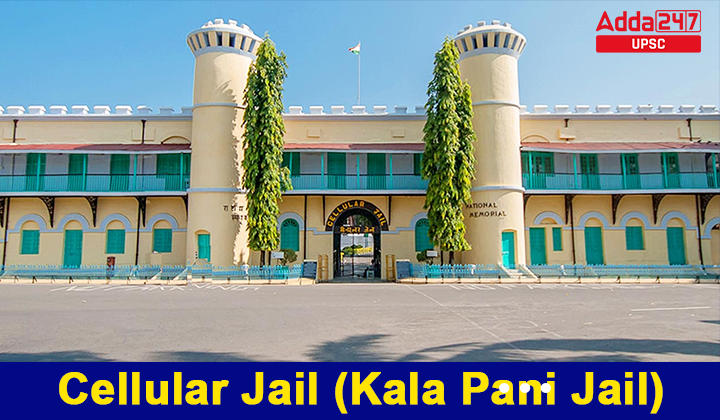Table of Contents
Cellular Jail
Cellular Jail also known as the Kala Pani Jail, is a historic and haunting prison located on the remote Andaman and Nicobar Islands of India. The British built the infamous Kala Pani Jail in the late 19th century to imprison and punish political dissidents and freedom fighters seeking independence from colonial rule. “Kala Pani,” or “black water,” signifies the prison’s isolation. The jail’s design featured individual cells to prevent communication, leading to brutal living conditions and immense suffering. Today, it stands as a national monument, symbolizing the sacrifices and resilience of those who fought for India’s freedom, a testament to the nation’s unwavering quest for independence and justice.
History of Cellular Jail (Kala Pani Jail)
- The history of the Cellular Jail, often referred to as Kala Pani Jail, is deeply entwined with India’s struggle for independence from British colonial rule. Construction of the jail commenced in 1896 and was completed in 1906. Located on the remote Andaman and Nicobar Islands in the Bay of Bengal, this prison was designed to incarcerate political dissidents and freedom fighters who posed a threat to British supremacy. The name “Cellular Jail” derives from its unique layout, comprising individual cells in a star-shaped pattern, intended to isolate inmates from each other and quell any potential rebellious communication.

- The conditions within Cellular Jail were notoriously harsh and inhumane. Inmates endured brutal treatment, forced labor, and solitary confinement in claustrophobic cells. The remoteness of the Andaman Islands added to the prisoners’ sense of isolation, making escape nearly impossible. The British used the jail as a means to suppress dissent and to break the spirit of those who fought for India’s freedom.
- Despite the unimaginable suffering, the inmates displayed remarkable resilience and unwavering dedication to the cause of independence. Many of them continued their struggle within the confines of the jail, using secret codes and messages to communicate. The sacrifices made by these prisoners and their unwavering commitment to the cause turned Cellular Jail into a symbol of resistance and courage.
- In 1942, during World War II, the Japanese captured the Andaman Islands, leading to the release of many political prisoners. The jail’s significance diminished after India gained independence in 1947. Today, it stands as a national memorial, a testament to the sacrifices and dedication of those who endured immense suffering for the cause of Indian independence. The Cellular Jail’s history serves as a stark reminder of the price paid for freedom and a testament to the indomitable spirit of those who fought against colonial oppression
Inside Cellular Jail
- It was used to exile political prisoners, who were often subjected to harsh and inhumane conditions. The prison is now a national monument and a popular tourist destination.
- The Cellular Jail is a seven-winged structure, with each wing radiating out from a central tower. The cells are small and cramped, with only a small window for ventilation. The prison was designed to isolate prisoners from each other, both physically and mentally.
- Many notable Indian freedom fighters were imprisoned in the Cellular Jail, including Vinayak Damodar Savarkar, Batukeshwar Dutt, and Yogendra Shukla. The prisoners were forced to perform hard labor and were often subjected to physical and mental torture.

- Despite the harsh conditions, the Cellular Jail became a symbol of Indian resistance to British rule. The prisoners continued to fight for their freedom, and their stories inspired generations of Indians.
- Today, the Cellular Jail is a reminder of the sacrifices made by Indian freedom fighters. It is a place where visitors can learn about the Indian independence movement and pay their respects to the martyrs who fought for India’s freedom.
- Inside the Cellular Jail, there is a museum that tells the story of the prison and its inmates. There is also a sound and light show that depicts the lives of the prisoners and their struggle for freedom.
- The Cellular Jail is a powerful reminder of the human spirit and the importance of fighting for freedom. It is a must-visit for anyone interested in Indian history and culture.
Cellular Jail Location

Cellular Jail is situated on the remote Andaman and Nicobar Islands in the Bay of Bengal, India. This historic penitentiary is located on South Andaman Island, specifically in Port Blair, the capital of the Andaman and Nicobar Islands. Its isolated location amidst the azure waters of the Bay of Bengal was strategically chosen by the British colonial rulers during the late 19th and early 20th centuries to house political prisoners, making it nearly impossible for inmates to escape. The harsh geographical setting of Cellular Jail played a crucial role in its reputation as a dreaded colonial prison and a symbol of the sacrifices made by Indian freedom fighters during the struggle for independence. Today, the Cellular Jail stands as a poignant monument to India’s freedom movement and a reminder of the resilience and courage of those who suffered within its walls.
List of 10 Freedom Fighters in Cellular Jail
Here is a list of 10 freedom fighters who were imprisoned in the Cellular Jail:
- Vinayak Damodar Savarkar
- Batukeshwar Dutt
- Yogendra Shukla
- Barindra Kumar Ghosh
- Ullaskar Dutt
- Upendranath Banerjee
- Hem Chandra Das
- Indu Bhushan Roy
- Bibhuti Bhusan Sarkar
- Rishikesh Kanjilal
These freedom fighters were all imprisoned for their role in the Indian independence movement. They were subjected to harsh and inhumane conditions in prison, but they never gave up their fight for freedom. Their stories are an inspiration to all of us, and they remind us of the importance of fighting for what is right, even when it is difficult.




 TSPSC Group 1 Question Paper 2024, Downl...
TSPSC Group 1 Question Paper 2024, Downl...
 TSPSC Group 1 Answer key 2024 Out, Downl...
TSPSC Group 1 Answer key 2024 Out, Downl...
 UPSC Prelims 2024 Question Paper, Downlo...
UPSC Prelims 2024 Question Paper, Downlo...




